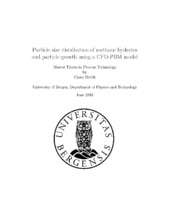| dc.description.abstract | Gas hydrates are solid crystalline compounds that contain water and gas molecules, and can be considered to be a natural occurring phenomena located in enormous amounts around the world. Particle growth and agglomeration of gas hydrates that leads to plugging of a pipeline can delay production significantly and even damage equipment. The increase in use of enhanced oil recovery (EOR) techniques causes more water to be produced. Therefore, research on a high water cut system contributes to understanding plugging formation mechanisms. This thesis presents two numerical experiments using computational fluid dynamics (CFD), which are conducted with a three-dimensional Eulerian-Eulerian approach using the simulation software Star-CCM+. In addition, mesh independence and validation of the simulations were also performed. The main objectives of the numerical experiments were to: determine and interpret the particle size distribution (PSD) of hydrate particles in a tank with different stirring rates caused by an impeller using a 5-phase CFD model, study particle growth and hydrate formation using a 2-phase CFD-PBM model, and do an analytical analysis of particle diameter size with different stirring rates using various methods. The reasearch was inspired by the work of Herri et al., where they found an increasing particle diameter size with the stirring rate. The analytical analysis revealed that almost all methods used resulted in too large values of particle diameter. However, a trend of decreasing particle diameter size with stirring rate could be seen. Furthermore, the exception was the method using an implicit relation developed by Zerpa et al., which was in coherence with the values from Herri et al., and showed a decreasing particle diameter size with stirring rate. The result of the numerical simulations using a 2-phase CFD-PBM model, showed that particle growth and particle diameter size increased with lower stirring rate, which are in coherence with the analytical analysis in this thesis. A possible explanation could be at a lower stirring rate, more particles gather in the top area of the tank, where both concentration of methane and growth rate are largest at this point. Therefore, particles may grow bigger around the top boundary of the tank. This reveals an opposite trend compared to the simulation model done by Herri et al., and the results from the 2-phase CFD-PBM model do not appear to be in qualitative agreement. A concept of a "bell" shaped curve for the mean particle diameter from the numerical simulations using a 5-phase CFD model was developed. At low shear and stirring rate, hydrates stay at the water-gas interphase due to buoyancy. Increased stirring rate, cause the largest particles to be transported up to the measurement location used in the model, where the particle diameter grow. However, if the stirring rate is increased further, the particle diameter is reduced again due to the slurry becoming homogeneous. | en_US |
